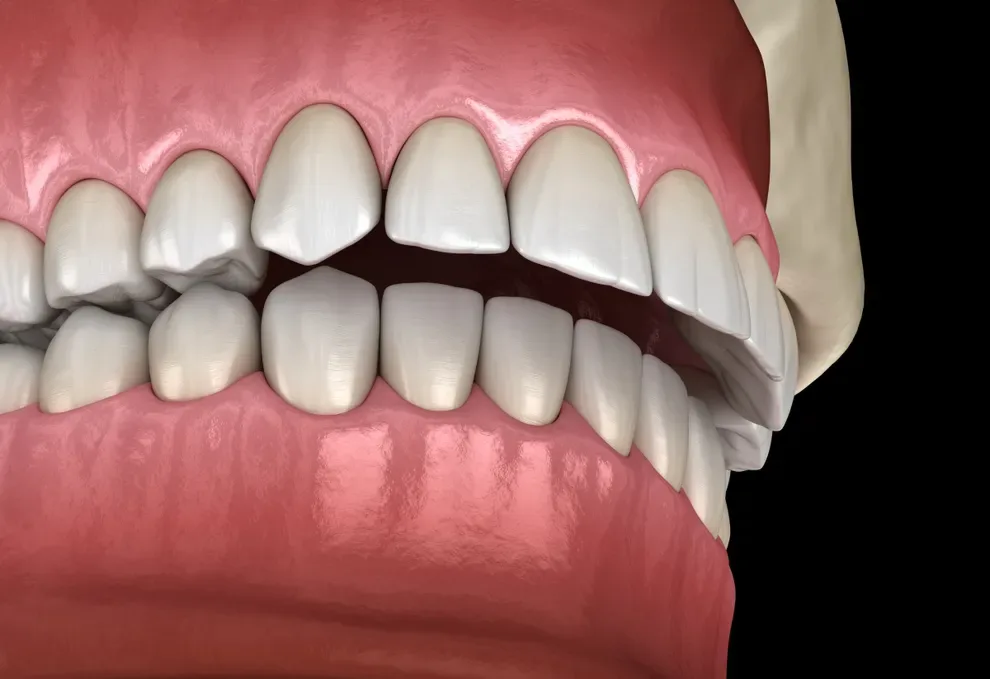Overjet vs. Overbite: What's the Difference?

Table of Contents
- Key Facts
- Overjet vs. Overbite
- Overjet & Overbite Causes
- Overjet & Overbite Symptoms
- Overjet & Overbite Correction
- Treatment Options
Overjet and overbite are two forms of malocclusion, or teeth misalignment. While overjet is often confused with overbite, they are actually two different conditions.
Overbite is a common misalignment problem. With an overbite, the upper front teeth overlap the upper bottom teeth too much.
Overjet occurs when the front upper teeth jut out in front of the bottom teeth and are angled outward.
Genetics are a leading cause of all malocclusions. Other factors may include childhood oral habits, missing teeth, and injury to the mouth or jaw.
Overbite and overjet can result in oral health problems if left untreated, including decay, gum disease, and jaw disorders.
The main treatment options for overbite and overjet are braces and clear aligners. If crowding is serious enough to prevent the teeth from shifting into correct positions with treatment, tooth removal may be needed. Severe cases of overjet or overbite may also require jaw surgery in addition to braces or aligners.
Key Facts about Overjet vs. Overbite
Both overjet and overbite are conditions of malocclusion, or teeth misalignment. They are both classified as Class 2 malocclusion.
Overbite is a vertical teeth misalignment in which the upper front teeth sit too far in front of the lower front teeth.
Overjet (sometimes called buck teeth) is a horizontal misalignment in which the upper front teeth protrude outward in front of the lower front teeth.
If left untreated, overbite and overjet can result in tooth decay, gum problems, weakened tooth enamel, problems eating and speaking, and jaw pain and dysfunction.
Treatment for overjet and overbite include braces and clear aligners. In cases involving crowding, tooth extraction may be necessary. Severe overjet or overbite may require jaw surgery.
Overjet vs. Overbite: What are They?
Overjet and malocclusion are conditions of teeth misalignment. This means that when you close your mouth, your upper and lower teeth don’t line up correctly.
There are generally three classes of malocclusion. Both overjet and overbite are considered Class 2 malocclusions.
What Causes Overjet & Overbite?
Most cases of overjet and overbite are caused by genetics, including hereditary jaw problems.
Other causes include the following:
Thumb sucking
Childhood pacifier use, especially after the loss of baby teeth
Prolonged bottle or sippy cup use
Jaw or mouth injury
Tooth loss
Dental appliances or applications that weren’t fitted properly, such as fillings, crowns, or retainers
Tumors
What are the Symptoms of Overjet & Overbite?
Often, overbite or overjet can be seen when a person is smiling. The upper front teeth may appear to sit too far in front of the lower front teeth. Overjet may be more noticeable than overbite. Often, people can spot the appearance of buck teeth.
Other symptoms of overjet and overbite may include the following:
Jaw pain or soreness
Cavities or gum irritation despite practicing good oral hygiene
Headaches
Speech and chewing problems
Feeling like teeth are “grinding” against each other
Teeth cutting into the gums or inner cheek
When Should you Correct Overjet & Overbite?
With malocclusion, the earlier you can correct the problem, the better.
Treating the problem as a child or adolescent has advantages. The mouth and jaw may be still developing, and they are then easier to influence with orthodontic appliances.
However, it’s never too late to fix an overbite or overjet. Correcting the issue can boost your confidence, and it will also improve your oral health (and thus, your overall health).
The crowding and/or gaps that malocclusion creates can make it hard to clean in between teeth. Crowding makes the space between teeth too narrow to get to with a toothbrush or floss. Gaps create open spaces in the gums that are vulnerable to bacteria. These issues increase the risk of tooth decay and gum problems.
Problematic bites can also cause friction and abrasion between different teeth and between gums and teeth. This increases the risk of damaged tooth enamel and gum disease. Problems with eating and speech can also occur.
Bad bites can also put strain on the jaw muscles and cause headaches, soreness, and jaw disorders like TMJ.
Treatment Options for Overjet & Overbite
The treatment options needed to correct overbite and overjet will depend on the severity of the problem and, in some cases, what’s caused it.
